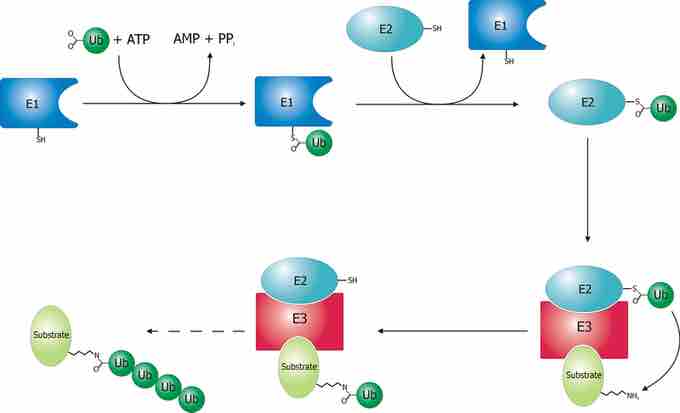Proteolytic degradation is necessary in the regulation of cellular processes and function. The breakdown of proteins into smaller polypeptides, or its respective amino acids, are necessary for metabolic and cellular homeostasis. Polypeptides are commonly broken down via hydrolysis of the peptide bonds by utilizing a class of enzymes called proteases. However, proteolytic degradation can also occur utilizing various mechanisms, including intramolecular digestion and non-enzymatic methods. The mechanisms of proteolytic degradation are necessary for obtaining amino acids via degradation of digested proteins, preventing accumulation or abnormal concentrations of proteins, and by regulating cellular processes by removing proteins no longer needed.
Proteasomes are protein complexes that function in the degradation of unneeded or damaged proteins via proteolysis. The proteasomes are a major component of a complex and highly regulated mechanism. The proteasome is able to degrade proteins based on the presence of a ubiquitinprotein. This ubiquitin sequence is a modification to proteins that are targeted for degradation. The recognition of this ubiquitin signal by the proteasome results in degradation of the protein into its amino acids, which are then recycled and reused for the synthesis of new proteins. The proteasomal degradation pathway is the major pathway utilized to ensure proteolytic degradation . It is necessary for homeostasis functioning in controlling cell cycle and gene expression, for example.

The Process of Protein Degradation in a Proteosome
Schematic of the proteolytic degradation pathway that utilizes proteasomal complexes. The protein is tagged with several ubiquitin signals that target the proteasome. Once the protein arrives at the proteasome, the protein is degraded into its amino acids which are then reused for synthesis of new proteins.
In addition to proteasomal complexes, the organelle, the lysosomes are also used to ensure protein degradation. The intracellular process that utilizes lysosomes involves autophagy. The lysosomal pathway, in comparison to the proteasomal pathway, is typically non-selective. The lysosome contains proteases that are able to target and degrade proteins.